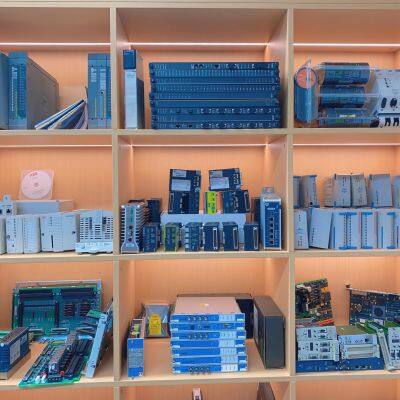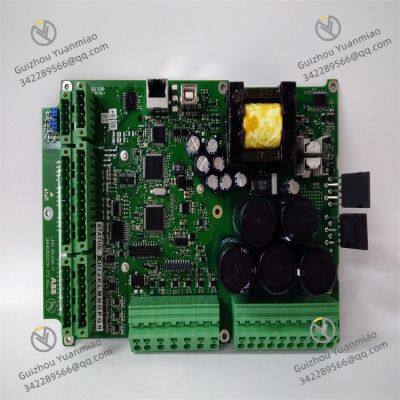Product Description
I. Overview
The ABB 3BHE004074R0511 is a core module for industrial process control under the Industrial IT series of the Swiss ABB Group. Its core positioning is to provide high-precision closed-loop control and logical interlocking functions for complex industrial processes (such as continuous reactions, multivariable regulation, and batch production) in industries including chemical engineering, oil and gas, electric power, and metallurgy. It is a key component of ABB AC 800M or Freelance series DCS (Distributed Control Systems).
Integrating multi-channel signal processing, high-performance control algorithms, and flexible communication interfaces, the module enables real-time collection, calculation, and control output of multiple types of process parameters such as temperature, pressure, flow rate, and liquid level. This ensures the stability, safety, and efficiency of industrial production processes. It is suitable for scenarios such as reactor control in large petrochemical plants, boiler water level regulation in power plants, and rolling mill process parameter control in metallurgical plants, effectively solving control challenges such as multivariable coupling, large time delay, and strong interference under complex working conditions.
The module adopts a standard 3U industrial board design (dimensions approximately 220mm×160mm×40mm), which is compatible with ABB standard cabinet slots and realizes high-speed data interaction with the system main controller via a backplane bus. Its housing is made of reinforced plastic (flame retardant rating UL94 V-0), featuring excellent insulation and heat dissipation performance. With an operating temperature range of -10℃~60℃, it can adapt to most industrial on-site environments. It supports redundant configurations (power redundancy, communication redundancy) and has a Mean Time Between Failures (MTBF) of ≥150,000 hours, meeting the strict requirements of industrial processes for control modules, including "high reliability, long service life, and strong adaptability".
The signal interface is compatible with analog, digital, and pulse signals, allowing direct connection to on-site sensors, actuators, and third-party intelligent devices, thus enabling rapid construction and expansion of control loops.

II. Technical Parameters
Electrical Parameters
2. Environmental and Reliability Parameters
3. Control and Communication Parameters

III. Functional Features
1. Multi-Channel and Multi-Type Signal Processing
The 3BHE004074R0511 has comprehensive signal processing capabilities, covering various common sensing signals in industrial processes and meeting the requirements of multi-parameter coordinated control:
Analog Signal Acquisition and Output
It integrates 8 analog input (AI) channels and 4 analog output (AO) channels. The AI channels support signal types such as 4-20mA DC, 0-10V DC, PT100/RTD (-200℃~850℃), and thermocouples (Type K/J/T), with 16-bit A/D conversion resolution, sampling accuracy of ±0.05% FS, and sampling period ≤100μs. For example, in chemical reactor control, it can simultaneously collect parameters such as reaction temperature (Type K thermocouple), reactor pressure (4-20mA), and feed flow rate (4-20mA) with a measurement error ≤0.1%, providing accurate data input for control algorithms.
The AO channels support 4-20mA DC or 0-10V DC output, with 12-bit D/A resolution and output accuracy of ±0.1% FS, which can drive actuators such as control valves and frequency converters. For instance, it outputs a 4-20mA signal to control the opening of a steam control valve based on temperature deviation, achieving stable regulation of reaction temperature.
Digital and Pulse Signal Interaction
It includes 16 digital input (DI) channels and 8 digital output (DO) channels. The DI channels support 24V DC dry/wet contact signals with a response time ≤1ms, and can collect on-site equipment status (such as valve opening/closing feedback, pump operation status, and fault alarm contacts). For example, in oil pipeline control, it collects status signals such as "overpressure alarm" from pressure switches and "flow interruption" from flow switches.
The DO channels adopt relay output (2A@250V AC/30V DC), support normally open/normally closed mode configuration, and can drive solenoid valves, indicator lights, and small relays to realize equipment start-stop control or interlocking actions. For example, after receiving an "emergency stop" command, it cuts off the power supply of the feed pump via the DO channel.
Meanwhile, the module is equipped with 2 pulse input (PI) channels that support 0-10kHz pulse signals and can be connected to devices such as vortex flowmeters and encoders to realize functions such as flow accumulation and rotational speed measurement.
Signal Anti-Interference Processing
All signal channels adopt optoelectronic isolation (isolation voltage ≥2.5kVrms) and EMC filtering design, complying with the IEC 61000-6-2 industrial anti-interference standard. They provide ESD protection of ±8kV (air discharge)/±4kV (contact discharge) and EFT (Electrical Fast Transient) protection of ±2kV, which can resist high-frequency electromagnetic interference generated by frequency converters and high-voltage motors in industrial sites, ensuring the stability of signal acquisition and output. For example, in rolling mill control in steel plants, the temperature signal collected by the module fluctuates by ≤0.1℃, avoiding control misoperations caused by interference.
2. High-Performance Control Algorithms and Logical Interlocking
The module has built-in multiple industrial-grade control algorithms and logical programming functions to meet the control requirements of complex processes:
Advanced Multivariable Control Algorithms
It supports algorithms such as PID (Proportional-Integral-Derivative), PID auto-tuning, cascade control, feedforward control, and ratio control. The PID auto-tuning function can automatically optimize PID parameters (proportional gain, integral time, derivative time) based on the dynamic characteristics of the process object (such as time delay and gain) without repeated manual debugging. For example, in boiler water level control in power plants, the module uses cascade PID control, with "water level" as the main control variable and "feedwater flow rate" as the secondary control variable, quickly offsetting the impact of feedwater pressure fluctuations on water level, with a control accuracy of ±5mm (water level range: 0-5m).
Feedforward control can pre-compensate for known interferences (such as changes in feed quantity). For example, in chemical distillation column control, the reflux rate is adjusted in advance according to changes in feed flow rate to avoid large fluctuations in column temperature.
Logical Interlocking and Batch Control
It integrates an IEC 61131-3 standard programming environment, supporting programming languages such as Ladder Diagram (LD), Function Block Diagram (FBD), and Structured Text (ST), enabling complex logical interlocking and batch production control. For example, in the batch reaction process of the pharmaceutical industry, FBD programming is used to realize sequential control of "feeding→heating→heat preservation→cooling→discharging", while setting interlocking conditions (such as cutting off heating if temperature exceeds the limit and emergency pressure relief if pressure is too high) to ensure the consistency and safety of batch production. The logical operation response time is ≤1ms, which can meet high-speed interlocking requirements (such as emergency valve closure within 100ms in case of oil pipeline leakage).
Data Calculation and Processing
Equipped with a built-in 32-bit floating-point arithmetic unit, it supports data processing functions such as four fundamental operations, trigonometric functions, and statistical analysis (e.g., average, maximum, minimum), enabling real-time calculation of collected process parameters. For example, in the continuous casting process of metallurgical plants, it calculates the average temperature of cast billets measured by multiple thermocouples, which serves as the basis for width and thickness adjustment control. It also supports historical data caching (capable of storing the latest 1,000 key parameter records), facilitating traceability of process fluctuation causes.
3. Redundant Design and High Reliability
To meet the demand for "continuous and uninterrupted production" in industrial processes, the UNS4681V511 enhances system reliability through multiple redundancy and protection designs:
Power and Communication Redundancy
It supports dual 24V DC redundant power inputs (18-32V DC wide voltage range) and has a built-in power monitoring and switching circuit. When any power supply is overvoltage (>32V DC), undervoltage (<18V DC), or power-off, it can automatically switch to the standby power supply within 50μs, ensuring uninterrupted power supply to the module's core circuit.
In terms of communication, it supports dual redundant backplane buses or redundant Ethernet (PROFINET/Modbus TCP). When the main communication link fails, it switches to the standby link within 100ms to avoid data transmission interruption. For example, in large petrochemical plants, the redundant design can reduce the system failure shutdown rate to below 0.01%.
Fault Self-Diagnosis and Fault Tolerance
It has a built-in full-link fault diagnosis function that can real-time monitor issues such as AI/AO channel open/short circuits, DI/DO contact faults, power abnormalities, and communication interruptions. The diagnosis results are intuitively displayed via LED indicators (PWR: green for power, RUN: green for operation, ERR: red for fault, COMM: yellow for communication). Meanwhile, fault codes (e.g., "E03: AI1 channel open circuit", "E12: DO4 relay fault") are uploaded to the DCS operator station via the communication interface, allowing maintenance personnel to quickly locate faults.
It also supports fault-tolerant control. When a non-critical channel fails, the module automatically activates a backup control strategy (such as replacing the faulty signal with a backup temperature sensor signal) to ensure the control loop is not interrupted.
Environmental Adaptability
With an operating temperature range of -10℃~60℃ and relative humidity of 5%~95% (non-condensing), it can adapt to high-humidity environments in chemical workshops and high-temperature environments in metallurgical workshops. The module surface is coated with a moisture-proof coating, and the PCB board adopts lead-free soldering technology (complying with RoHS 2.0 standard). Key components (such as operational amplifiers and relays) are industrial-grade long-life devices (service life ≥10 years), ensuring long-term stable operation.
4. Flexible Communication and System Integration
The module has rich communication interfaces, enabling seamless integration with DCS systems, on-site equipment, and industrial Internet platforms:
Local Bus Communication
It connects to the ABB AC 800M or Freelance main controller via a dedicated backplane bus with a transmission rate of 40MB/s, supporting high-speed interaction of real-time control data (such as set values, measured values, output values) and diagnostic information. The data transmission delay is ≤1ms, meeting the real-time control requirements of industrial processes (such as millisecond-level pressure regulation).
Industrial Ethernet and Fieldbus
It is equipped with 1 PROFINET interface (transmission rate: 100Mbps) and 1 Modbus TCP interface, which can be connected to the factory industrial Ethernet to realize data interaction with operator stations, engineer stations, and historians (historical databases). It also supports Modbus RTU (RS485) fieldbus, which can connect to third-party intelligent devices (such as intelligent transmitters and frequency converters). For example, in a water treatment plant, the module collects the frequency of the dosing pump frequency converter via Modbus RTU and uploads it to the central control room via PROFINET, realizing remote monitoring and regulation of the dosing process.
System Compatibility
It is fully compatible with the ABB Industrial IT software platform (such as Control Builder M and Operation Builder). Engineers can use Control Builder M software to configure parameters for the module (such as channel signal type and PID parameters), write programs (logical interlocking and control algorithms), and perform online debugging. It supports the "online download" function, allowing modification of control programs without shutdown, which adapts to the "maintenance without production interruption" requirement of industrial processes.


ABB 3BHB006716R0217 Digital Synchronizer
ABB Synchrotact5 SYN5302a-Z,V277 Digital Synchronizer
ABB 3BHB006716R0277 Digital Synchronizer
GE IS200AEADH1AAA Input/Output Grid Fork Board
Basler Electric DECS125-15-B1 Digital Excitation Controller
BENTLY NEVADA 3701/55 ADAPT Condition Monitor
GE L90-W03-HKH-F8L-H6P-L6C-N6C-S6C-U6L-W7G Multilin L90 protector
ABB PM863K01 3BSE088381R1 AC 800M processor unit Controller
ABB NGC8206 Natural Gas Chromatographs
Lam Research 810-068158-014 PCBA CIRCUIT BOARD
GE DS200TCDAH1BJE Mark V Digital I/O Board
ABB 086329-004 End Column Sensor Module
 yezi
Hi there! Welcome to my shop. Let me know if you have any questions.
yezi
Hi there! Welcome to my shop. Let me know if you have any questions.




